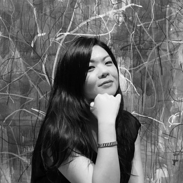Art Fairs
Collaboration Is Fueling a Renaissance in Kyoto’s Art Scene
Exhibitors at the fourth edition of Art Collaboration Kyoto said it takes time to make sales but the real value of the fair is in its 'personal' touch.
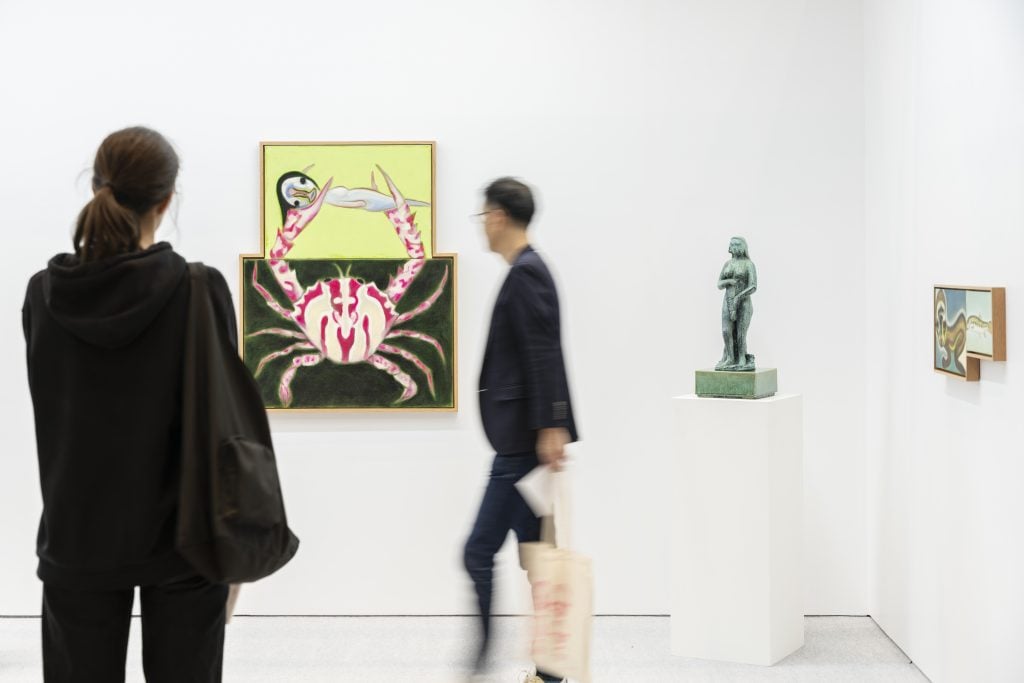
A chicly attired crowd gathered in an alley deep in a cluster of machiya, or traditional wooden townhouses, in Kyoto’s Gion district on Wednesday evening. They were admiring the paintings of the Japanese artist Ulala Imai at Nonaka-Hill’s new space, which is also the Los Angeles-based gallery’s first overseas outpost.
Gallery co-founder Rodney Nonaka-Hill has been exhibiting contemporary art from Japan and its diaspora since the gallery’s inception in 2018. Opening a space in Kyoto is a realization of his lifelong dream to live in Japan. His inroads to the city’s scene began with exhibiting at Art Collaboration Kyoto (ACK) for the first time in 2022, where he shared a booth with local gallery Shibunkaku.
“Many artists we work with have a relationship with Kyoto and the region,” Nonaka-Hill said, adding that he hoped to introduce works and perspectives from overseas to the local environment. “We feel that we can be more collaborative by having a space here.”
ACK has made collaboration a key force among Kyoto’s art scene. The unique fair, now in its fourth edition, requires Japan-based exhibitors to host an international gallery as part of their presentation. But partnership “goes beyond simply sharing a booth,” according to Yukako Yamashita, the fair’s program director. “The spirit of collaboration is everywhere across the city.”
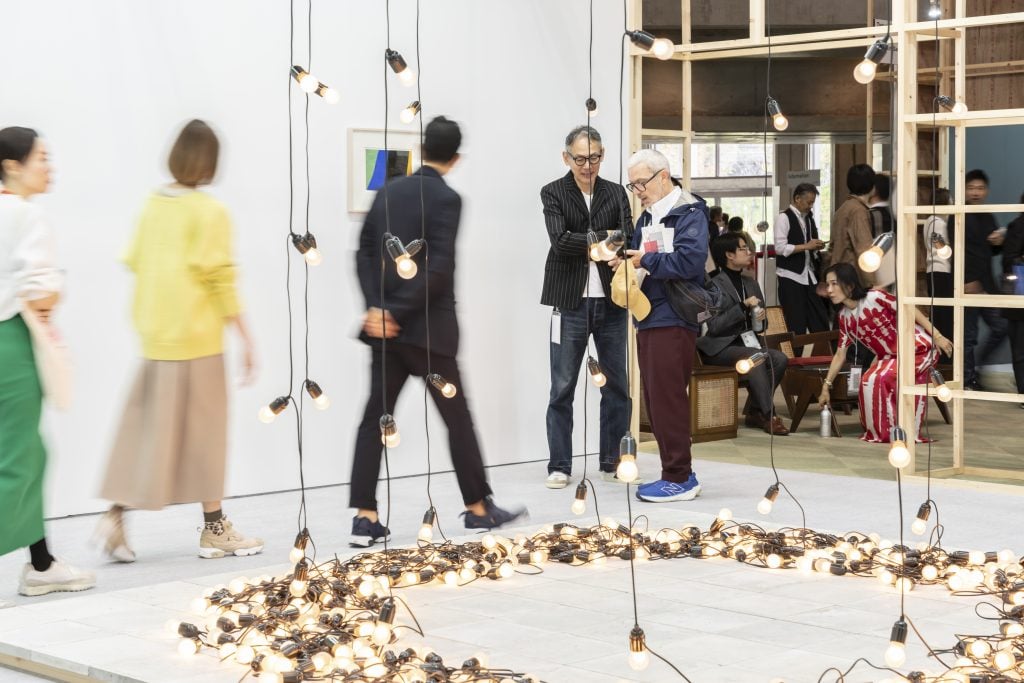
Taro Nasu and Matthew Marks Gallery at ACK 2024. Photo: Moriya Yuki. Courtesy of ACK.
The government-backed fair returned to the Kyoto International Conference Center on Thursday for a fourth edition with 69 galleries from 18 countries or regions, up slightly from last year’s 64 exhibitors. Among them, 33 galleries are joining the fair for the first time, which roughly tracks with the number of new faces last year.
When asked about the high turnover rate among galleries, Yamashita noted that the young fair has grown very popular within a short amount of time since its launch in 2021. The number of applications received this year was up by 35 percent from 2023, and the Japan-based galleries chose which overseas galleries they wanted to partner with as guests. “I even received inquiries about applications for the 2025 edition,” she said. Yet the fair had no intention to expand beyond its current scale. “We want to grow steadily.”
Thursday’s VIP preview saw collectors from Japan as well as those from around the region including Taiwan, mainland China, Singapore, Indonesia, Taiwan, and Hong Kong as well as some collectors from Europe. The friendly price points of works on display, ranging from a few hundred dollars into the five-digit range, may have contributed to the relaxing atmosphere as exhibitors felt less pressured to push for early sales. Still, by the end of the first day, some galleries had moved work or at least had pieces placed on hold.
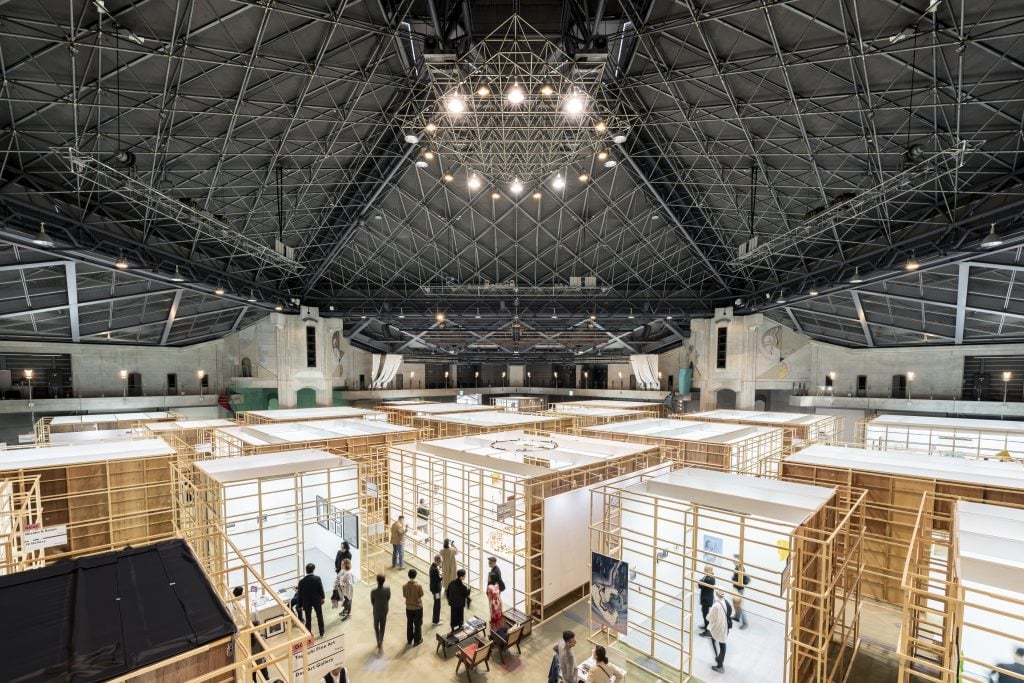
ACK 2024. Courtesy of ACK. Photo: Moriya Yuki.
The theme of collaboration is embedded in the fair’s two sections. “Kyoto Meetings” features 13 homegrown and overseas galleries showcasing works that have connections with the historic Japanese city. The main section, meanwhile, boasts 27 Japan-based galleries sharing booths with 29 international galleries from across the Americas, Europe, and the Asia-Pacific region.
Among the newcomers this year is the Icelandic gallery i8, which is showing with the Tokyo-based outfit Misako and Rosen. The two galleries are presenting a solo booth of Japanese artist Yui Yaegashi, who is represented by both galleries. They sold several small abstract paintings, priced between $6,000 and $11,000, on the first day of the fair.
Börkur Arnarson, owner and director of the Reykjavik-based gallery, said he prefers ACK’s model to “the usual competitive format” of art fairs. “It’s benefiting for artists to have galleries [that] can work with each other,” he said. “Our host has been very generous and introduced us the collectors they know. [I] hope we can return with some new contacts.”
Emi Eu, the executive director of the STPI – Creative Workshop & Gallery—a first-time exhibitor hosted by Tokyo’s Maho Kubota Gallery— noted that the fair’s size and collaborative nature made it “a jewel” of art platform, and having a contemporary art fair in the historical city of Kyoto offered new perspectives to art and culture. “We need this personal, sensible touch,” she said.
The Singaporean gallery made some sales on the VIP day, but Eu noted that it has become more challenging—but not necessarily because of the market. “There is a new crowd. It becomes increasingly evident to me that it is getting more difficult to sell when the artist is not known in the place you are exhibiting,” she said. “More engagement is needed.”
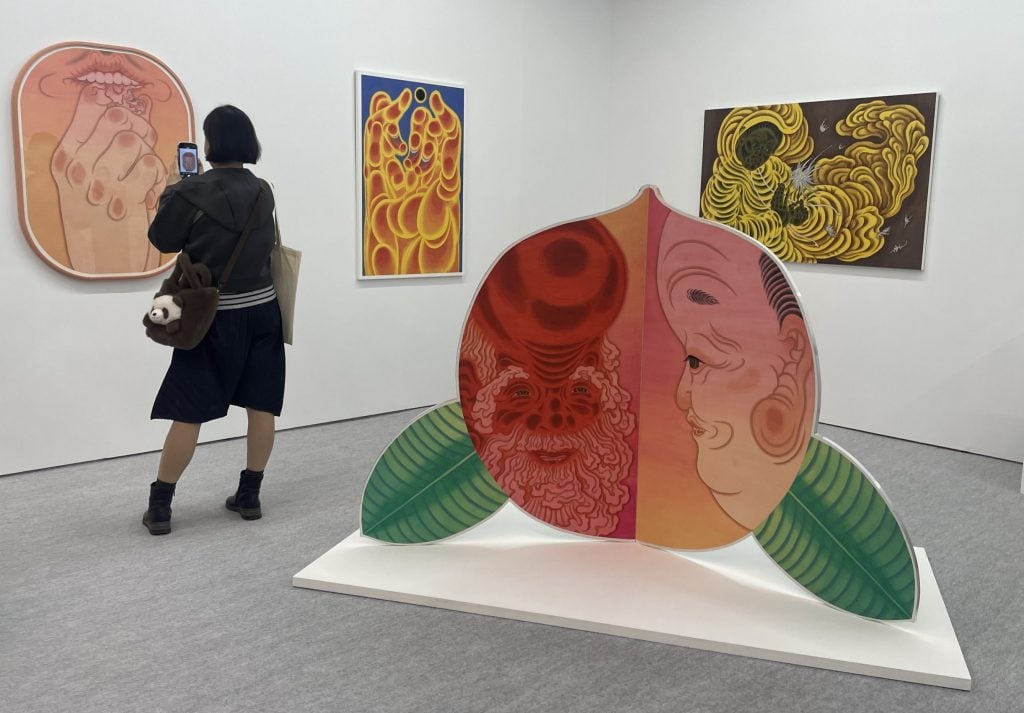
Paintings of Taiwanese artist Tseng ChienYing on view at the shared booth of Tomio Koyama Gallery and Each Modern at ACK 2024. Photo: Vivienne Chow
Returning exhibitors echoed this sentiment. Martin Aguilera, a partner at Mendes Wood DM, said, “Japan is not a place you arrive and start selling.” The gallery is exhibiting at ACK for a second time, this time sharing a booth with Tokyo gallery Kayokoyuki.
“It takes time to cultivate the market. Brazil has the largest Japanese population outside of Japan, and we hope to bring works that are related to what’s happening in the country,” Aguilera noted. The gallery sold several works priced from $25,000 to $70,000, including two editions of sculptures by the Brazilian artist Solange Pessoa as well as one painting by Brazilian painter Paula Siebra.
Even if it takes time to get one’s foot in the door in the region, there’s some business to be had as evidenced on the opening day of the fair. Seoul’s Johyun Gallery, which is exhibiting in the Kyoto Meetings section, sold Park Seo-bo’s Ecriture No.130417 (2013) for between $450,000 and $500,000—the highest reported sale of the fair so far. The gallery also sold nine works by Lee Bae, including canvas works each priced between $60,000 and $65,000 and two sculptures at $30,000 to $35,000 each. Blum, which is partnering with the Warsaw-based Foksal Gallery Foundation, sold several pieces, including ceramic works by Japanese artist Akane Saijo priced between $3,500 and $10,000.
Kyoto gallery Kanegae, which teams up with The Shophouse from Hong Kong, sold 30 small ceramic works by Japanese artist Ryuta Fukumura, each for 16,500 yen to 33,000 yen ($108 to $216), as well as some larger pieces by the artists each priced between 99,000 yen to 935,000 yen ($648 to $6,124). The gallery also sold sculptures by the Basel-born David Bielander priced between 594,000 yen and 1.3 million yen ($3,891 and $8,646) as well as a drawing by Yuichiro Sato for 2.5 million yen ($16,573).
The booth shared by the Tokyo-based Tomio Koyama Gallery and Each Modern of Taipai was swamped with visitors at one point. The former sold several paintings by Japanese artist Koji Nakazono for a four-digit sum each. The latter’s presentation of paintings by Taiwanese painter Tseng ChienYing, priced between $15,000 and $30,000, had an overwhelming response: The gallery’s founder, Huang Yaji, said two to three collectors were competing for each painting. “Tseng’s paintings are very popular right now among collectors from mainland China and Taiwan,” she said.
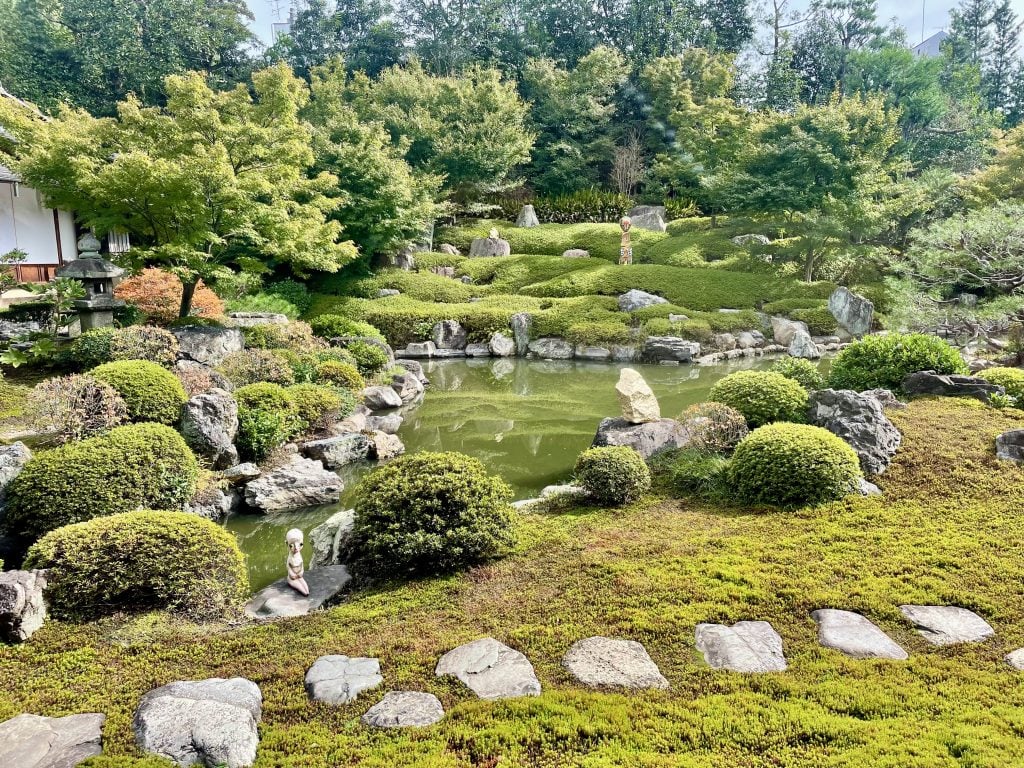
Installation view of “Speaking in Silence,” a collaboration between Izumi Kato and Bosco Sodi at Ryosokuin Zen Temple in Kyoto, October 31, 2024. Photo: Vivienne Chow.
First-time exhibitor Galerie Marguo of Paris, which shared a booth with the Kyoto gallery Cohju, had paintings by the London-based Thai artist James Prapaithong (priced between $7,800 and $27,000) were on hold. Hong Kong’s Rossi and Rossi, which shared a booth with the Tokyo gallery Satoko Oe Contemporary, brought seven collage works priced $2,000 to $4,000 by Christopher Doyle, the award-winning cinematographer of Hong Kong director Wong Kar-wai’s films, which have a huge following in Japan.
Site-specific works also attracted some attention from VIPs, among them marble sculptures of white trash bags by the Japanese artist collective Chim ↑ Pom and Taiwan-based Hong Kong artist Lee Kit’s conceptual laundry installation in the garden. The works are part of the fair’s public program, which is helmed by the Hong Kong-based curator duo Arts Collective, formed by Chin-Yin Chong and André Chan.
Outside of the fair grounds, the Berlin gallery Neugerriemschneider presented Swedish artist Andreas Eriksson’s first solo show in Japan, with his paintings reflecting his experiences in Japan earlier this year exhibiting at the fair’s Kyoto Meeting sector and the historic Murin-an gardens, which collaborated with the gallery for a contemporary art show during ACK week for the first time. Mendes Wood DM organized a solo exhibition of Brazilian artist Lucas Arruda at Daitokuji, a historic Zen temple founded in 1315.

Installation view: Andreas Eriksson, Rakuyou, Murin-an, Kyoto. © Andreas Eriksson. Courtesy the artist and neugerriemschneider, Berlin. Photo: Yuki Moriya
In addition to his fair presence, Chinese artist He Xiangyu is featured in two solo exhibitions as part of ACK’s Open Call Programs. “The Memory of Stillness,” is on show at the Manshu-in Temple. Organized by Hattori Shoji Corporation and SCAI The Bathhouse, the exhibition marked the historic temple’s first time collaboration with a contemporary artist during this art week. “Hazy Window” is a collaboration with Kyoto art space Artro.
The collaboration between Japanese artist Izumi Kato and Mexican artist Bosco Sodi led to the stunning exhibition “Speaking in Silence” at the Ryosokuin Zen Temple. The sculptures and walled works by the two artists, who share a two-decade long friendship that began in the early days of their careers, were harmonically integrated into the historic setting of the six-century-old temple.
“Compared to a white-cube setting, this exhibition works a lot better in an environment like this,” Kato said. “I want to show that our works are not just for museums but also for everyday life. The context is very important, otherwise it would be meaningless.”
Art Collaboration Kyoto runs through Sunday, November 3, at the Kyoto International Conference Center, Kyoto, Japan.
This article was updated on November 5.

